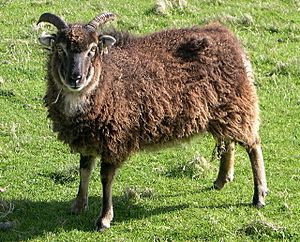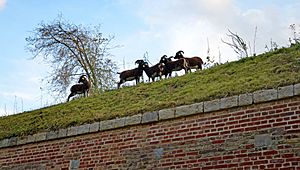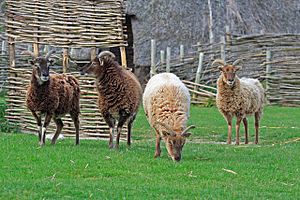Soay sheep facts for kids

Soay ewe
|
|
| Conservation status | RBST (2017): Category 4 |
|---|---|
| Country of origin | Scotland |
| Traits | |
| Wool color | Black, brown, blonde or dark brown with buffish-white underbelly and rump |
| Horn status | Horned |
|
|
The Soay sheep is a special type of domestic sheep. It comes from a group of wild sheep living on the island of Soay. This island is part of the St Kilda Archipelago in Scotland. It's about 65 kilometres (40 mi) from the Western Isles. The Soay sheep is one of the Northern European short-tailed sheep breeds.
These sheep look a lot like the wild ancestors of today's domestic sheep. These ancestors include the Mediterranean mouflon and the horned urial sheep from Central Asia. Soay sheep are much smaller than most modern sheep. But they are also tougher and very good at climbing. They often hide among cliffs when they get scared.
Soay sheep can be solid black or brown. More often, they are blonde or dark brown. They have a buff-white belly and rump. Some even have white marks on their faces.
In the early 1900s, some Soay sheep were moved to start new groups. For example, a group called "Park Soay" was started at Woburn Abbey in 1910. Later, in the 1930s, more Soay sheep were moved from Soay to Hirta. Hirta is another island in the St Kilda group. This happened after people and their sheep left Hirta. The name "Soay" comes from an old language, meaning "Island of Sheep." These sheep also live wild on Holy Isle near Arran.
Soay sheep were also brought to Lundy, an island in the Bristol Channel. This happened in 1925. There's also a small group living wild near Cheddar Gorge in Somerset.
Soay sheep are very tough and have been allowed to live mostly wild. The Rare Breeds Survival Trust lists them as "Category 4: At Risk." This means there are only about 900 to 1500 registered Soay ewes (female sheep) left. The Soay is different from other short-tailed sheep breeds. These include the Boreray and the Hebridean sheep.
Scientific Study

The Soay sheep living on Hirta have been studied by scientists since the 1950s. These sheep are a perfect example for scientists to learn about. They help us understand how animals change over time (evolution). They also show how animal numbers grow and shrink (population dynamics). This is because the sheep live on their own. No new sheep come in, and no sheep leave. Also, they don't have many enemies or other animals competing with them.
Scientists have noticed something interesting about their population. Their numbers never stay the same. The population grows so much that there isn't enough food on the island. This causes a huge drop in their numbers, and then the cycle starts again. For example, in 1989, two-thirds of the sheep died in just 12 weeks.
The age and sex of the sheep affect when these crashes happen. For instance, adult male sheep are not in good shape after the autumn mating season. Female sheep, however, have been eating all summer and are in good condition. The survival of males and lambs depends on the winter weather. The survival of females and young sheep is most affected by rain at the end of winter. This is when they are usually pregnant. Rain soaks their wool, making them use more energy to stay warm.
Another thing that affects how many sheep die is tiny worms called nematodes. These worms live in the sheep's intestines. They are especially harmful to sheep that don't get enough food.
Soay sheep were also used in experimental archaeology at Butser Ancient Farm. This is because they look very similar to sheep from ancient times in Britain.
Scientists have also found that the breed is getting smaller. This is likely due to changes in the climate.
Breed Characteristics
Soay sheep have short tails. They naturally shed their wool in the spring and early summer. This means their wool can be gently pulled off by hand, a process called "rooing." About one kilogram of wool can be collected from each sheep every year. Female Soay sheep (ewes) can be without horns, have small horn-like bumps (scurred), or have horns. Male sheep (rams) usually have horns or are scurred.
Most Soay sheep are brown or tan. They often have a white belly, a white patch on their rump, or a white patch under their chin. This is called the "Mouflon" or "wild pattern." Sometimes they have white marks on their face, body, or legs. Rarely, you might see a solid black or tan sheep with no markings.
This breed has very fine wool. Unlike mouflon, their inner wool is very well developed. It's hard to tell the difference between their outer and inner coats. This shows that Soay sheep are indeed a product of domesticated sheep from long ago. These sheep also don't like to stay in a big group like many other sheep breeds. If you try to herd them with sheepdogs, they tend to scatter.
Soay lambs grow slowly. They produce smaller amounts of meat compared to common farm sheep. The meat from Soay sheep is lean, tender, and low in cholesterol. It has a stronger, more wild taste than meat from other sheep breeds. If you cross Soay sheep with larger breeds like the Suffolk or Mule, you can get more meat. This meat will still be lean and have much of the Soay's unique flavor.
The Soay sheep is very similar to another wild sheep type. This type lived on the island of Lítla Dímun in the Faroe Islands. But it died out in the mid-1800s, partly because too many were hunted.
Images for kids
See also
 In Spanish: Oveja de Soay para niños
In Spanish: Oveja de Soay para niños







